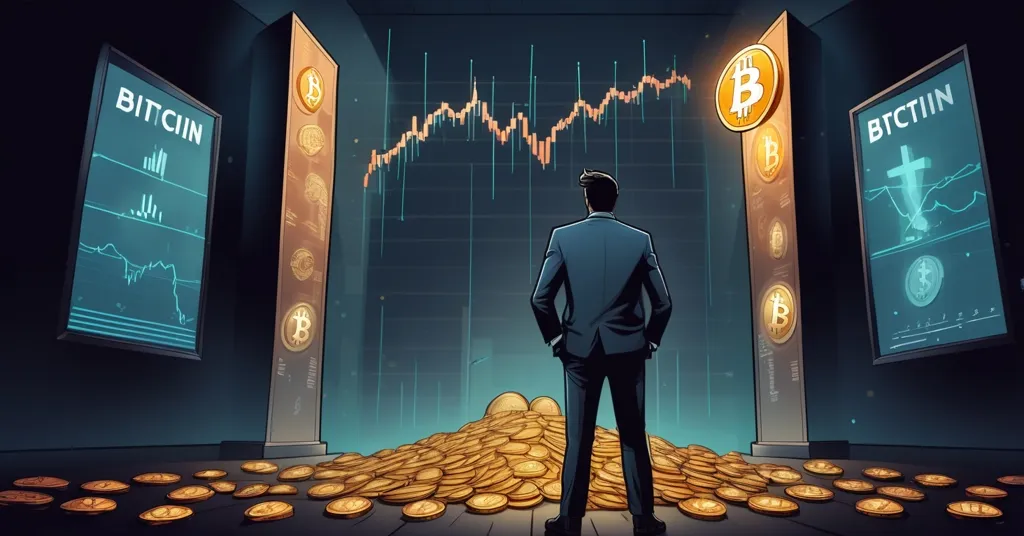Crypto ETFs Boom, Solana Stalls, and Mutuum Finance Presale Sparks Hype and Doubt

Crypto Market Shifts: ETF Inflows Signal Trust, Solana Hits Walls, and Mutuum Finance Sparks Debate
Big money is pouring into Bitcoin and Ethereum ETFs, showcasing a renewed wave of confidence in crypto as economic uncertainty looms. Meanwhile, Solana (SOL) grapples with stubborn price barriers, and a new DeFi player, Mutuum Finance (MUTM), is making noise with a presale haul that’s turning heads—but not without raising eyebrows.
- ETF Surge: Bitcoin and Ethereum ETFs see massive investments, reflecting institutional and retail trust.
- Solana’s Struggle: SOL faces selling pressure at $203 and $212, frustrating short-term investors.
- Mutuum Finance Buzz: DeFi presale project MUTM raises $18.27M, touting an innovative lending model.
Bitcoin and Ethereum ETFs: Institutional Muscle Flexes
The crypto market is getting a hefty vote of confidence as Bitcoin and Ethereum ETFs draw significant capital in the last quarter. We’re talking serious inflows—estimates suggest over $2 billion into funds managed by heavyweights like BlackRock and Fidelity, though exact figures vary by source. For the uninitiated, ETFs, or exchange-traded funds, are financial instruments traded on stock exchanges that track the price of assets like Bitcoin (BTC) or Ethereum (ETH). They let traditional investors dip their toes into crypto without wrestling with private keys or hardware wallets. It’s like buying a slice of the pie without baking it yourself. This trend isn’t just a fleeting hype cycle; it echoes the 2021 Bitcoin ETF approvals that first cracked open the door to Wall Street. Today, amidst inflation fears and shaky fiat markets, these inflows signal that crypto is increasingly seen as a hedge—a digital lifeboat in choppy economic waters.
But let’s not get carried away with ticker-tape parades. While institutional backing is a win for legitimacy, it’s not a golden ticket. Risks loom large—regulatory clampdowns could stall ETF growth, and overexposure to volatile assets might spook conservative investors if Bitcoin takes a nosedive. Plus, ETFs don’t embody the raw, decentralized ethos of holding your own coins. They’re a middleman’s game, and in a space born to disrupt intermediaries, that’s a bitter pill for purists. Still, for Bitcoin maximalists like myself, this cements BTC as the unshakeable anchor of trust in crypto, even as other projects vie for attention.
Solana’s Price Woes: Speculation Trumps Substance
While the big two bask in institutional glow, Solana (SOL) is stuck in a rut that’s got holders sweating. The price keeps flirting with breakouts around $203 and $212, only to get smacked down by waves of selling. For those new to the term, these “resistance levels” are like invisible ceilings where selling pressure often spikes—think of it as a crowd rushing the exit at the first sign of profit. This profit-taking creates a vicious cycle: brief rallies fizzle into crashes, leaving short-term speculators with nothing but regret and a lighter wallet. Solana, a layer-1 blockchain built for speed, can process thousands of transactions per second—imagine a super-fast highway compared to Ethereum’s bumper-to-bumper traffic. It’s a darling for DeFi apps and NFT marketplaces, but right now, that tech prowess isn’t translating to price stability.
What’s behind this mess? Beyond the obvious speculative gambling that plagues most altcoins, Solana’s had its share of hiccups. Network outages in the past—though less frequent now—have dented confidence, and competition from other layer-1s like Avalanche or Polygon keeps the pressure on. Unlike Bitcoin, often called digital gold for its store-of-value narrative, Solana’s worth is tied to network usage and hype, both of which can evaporate faster than a meme coin’s 15 minutes of fame. Are we looking at a fundamental flaw, or just the usual crypto casino chaos? Either way, SOL holders are praying for a breakout harder than a kid waiting for summer break. It’s a harsh lesson: even the shiniest altcoins can’t escape the market’s mood swings.
Mutuum Finance: DeFi’s Latest Gamble or Game-Changer?
Amidst the ETF boom and Solana’s stumbles, a new name is buzzing in the DeFi arena—Mutuum Finance (MUTM). For those scratching their heads, DeFi, or decentralized finance, refers to blockchain-based systems that aim to replace traditional financial middlemen like banks with code-driven protocols. Mutuum has roped in over 17,660 investors, raising a hefty $18.27 million in its presale, now in Phase 6 with tokens priced at $0.035—a 250% jump from the $0.01 starting point. With 85% of this phase sold, the price is slated to rise nearly 20% to $0.04 in Phase 7. Early investors are eyeing potential returns of up to 420% when the token launches at $0.06, sweetened by gimmicks like a 24-hour leaderboard ($500 MUTM bonus to the top daily depositor, resetting at 00:00 UTC) and a $100,000 prize pool splitting $10,000 among 10 lucky winners. On paper, it’s a tantalizing pitch.
What sets Mutuum apart, they claim, is a dual-market lending model—a blend of peer-to-contract and peer-to-peer systems. In the peer-to-contract setup, users stake assets like Ethereum or stablecoins (e.g., USDT) into liquidity pools, where algorithms automatically match borrowers and lenders for hassle-free returns. Picture tossing spare change into a vending machine that spits out interest. The peer-to-peer side offers more control, letting lenders set custom terms for less liquid or niche tokens—think of directly negotiating a loan with a buddy. The goal? Maximize returns while sidestepping traditional finance’s gatekeepers. In a DeFi landscape often cluttered with recycled ideas, this approach feels like a breath of fresh air, potentially filling a niche that Bitcoin’s simplicity or Ethereum’s high fees can’t touch.
But let’s cut the crap—this isn’t a fairy tale, and I’m not here to shill. The “best crypto to buy” label Mutuum slaps on itself is pure marketing hogwash, a red flag that reeks of desperation to lure in suckers. Presale hype is a notorious double-edged sword in crypto. Sure, $18.27 million sounds impressive, but untested DeFi projects are a graveyard of broken dreams. Many collapse under buggy code, vanish in rug pulls, or get crushed by regulators sniffing around unregistered securities. DeFi lending itself faces systemic issues—hacks drain millions annually, and overcollateralization (requiring borrowers to lock up more value than they borrow) can scare off users. Does Mutuum have audits? A transparent team? Real-world traction? Without those answers, this is a gamble, not a guarantee. I’m all for disruptive innovation—hell, it’s the lifeblood of decentralization—but blind faith in presales is a death sentence. For deeper insights into the challenges facing MUTM and Solana’s price resistance, check out this detailed analysis on ETF inflows and crypto market trends.
Playing devil’s advocate, though, if Mutuum delivers, it could challenge established lending giants like Aave or Compound by blending efficiency with flexibility. It might address liquidity crunches for smaller tokens that bigger platforms ignore, carving out a unique spot in the ecosystem. While Bitcoin remains the ultimate store of value, and Ethereum the smart contract king, niche DeFi plays like this could drive the next wave of financial freedom. But “could” is the operative word. Tread carefully, folks.
Broader Market Context: Why Now?
Zooming out, these three stories—ETF inflows, Solana’s volatility, and Mutuum’s presale—reflect a crypto market in flux, tugged between maturity and madness. Macro factors like rising interest rates and persistent inflation are likely pushing investors toward Bitcoin and Ethereum as alternative assets, explaining those ETF numbers. Yet, the speculative fever that fuels altcoins like Solana hasn’t cooled, showing how far we are from a truly stable space. And DeFi projects like Mutuum? They’re the wildcards, promising to upend finance while often overpromising to naive investors. It’s a reminder that crypto isn’t just tech—it’s a battleground of trust, risk, and relentless innovation. Whether you’re a Bitcoin diehard or an altcoin adventurer, navigating this terrain demands skepticism as sharp as your optimism.
Key Takeaways and Questions Unpacked
- What’s behind the surge in Bitcoin and Ethereum ETF inflows?
Over $2 billion in investments in the last quarter, driven by institutional and retail confidence, points to crypto as a hedge against economic uncertainty like inflation or fiat instability. - Why is Solana stuck below $203 and $212 price levels?
Selling pressure from profit-taking investors creates a cycle of short-lived rallies and crashes, underscoring the speculative volatility of altcoins compared to Bitcoin’s steadier narrative. - Is Mutuum Finance a safer investment than volatile altcoins?
Despite raising $18.27M in its presale and offering a novel lending model, MUTM is untested and carries risks like project failure or regulatory scrutiny—hardly a “safe” bet. - How does Mutuum’s dual-market lending model stand out?
It mixes peer-to-contract pools for automated, efficient staking of assets like ETH with peer-to-peer options for custom terms on niche tokens, aiming to optimize returns without middlemen. - Should investors prioritize presale DeFi projects over established coins?
It’s a high-risk, high-reward call—presales like MUTM offer big potential gains but often flop, while coins like Bitcoin have staying power but slower growth spikes. - How do ETF inflows impact Bitcoin’s price stability?
They bolster demand and legitimacy, potentially reducing wild price swings, though regulatory risks or market overexposure could still trigger volatility. - What broader risks do new DeFi projects face compared to blockchains like Ethereum?
Beyond hacks and scams, they lack the battle-tested resilience and developer ecosystems of platforms like Ethereum, making failures more likely without rigorous audits or transparency.
Peering through the noise, one thing is crystal clear: crypto remains a frontier of staggering potential and sobering pitfalls. Bitcoin and Ethereum ETFs mark a step toward mainstream acceptance, but they’re no shield against market tremors. Solana’s woes highlight the fragility of hype-driven altcoins, a cautionary tale for anyone chasing quick riches. And Mutuum Finance embodies the double-edged sword of DeFi—brimming with promise yet fraught with uncertainty. As champions of decentralization and disruption, we must push for progress with eyes wide open. Innovation is our engine, but skepticism is our brake. Stack your sats, question every pitch, and remember: in this game, the only sure bet is doing your own damn research.



